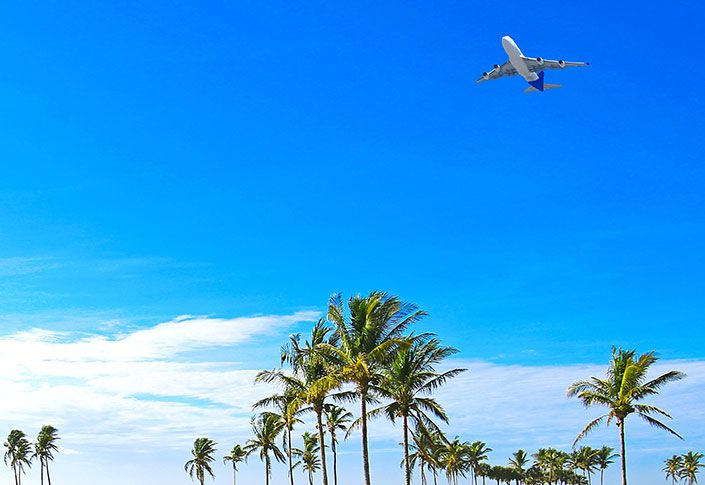Where travel agents earn, learn and save!
News / Airlines are ditching business hubs and rerouting flights to Florida
Maps are being overhauled to reflect new demand. Here’s what you need to know.

February 8 - There were 13,600 passenger flights around the globe on April 25, 2020—the lowest recorded number during the pandemic. It was an 86% drop in traffic compared to a few months earlier, according to travel analytics company Cirium. There was nowhere to go but up, up, and away.
And yet, nine months later, Cirium estimates that 30% of the global commercial airplanes remain in storage. OAG, another aviation data and analytics company, reported that seat capacity remained at 50% in January 2021, compared with a year earlier. And new estimates from the International Air Transport Association show that recovery will be slower than expected; rather than seeing a 50% rebound by the end of 2021, as previously anticipated, the trade body is now looking at a worst-case scenario of 13% improvement in passenger traffic, compared to 2020 figures.
As a result, airlines are getting scrappy, shifting operations to wherever there may be demand. The CliffsNotes version: Leisure is in, business travel is out. But much like a rewritten route map, the ramifications for consumers span far and wide.
Fewer connections, more sun
Leisure travel has showed early signs of a comeback, with summer and holiday travel spikes. Business travel, on the other hand, may be permanently curtailed by Zoom; such prominent thinkers as Bill Gates forecast that business travel will permanently drop by 50%. In response, says Henry Harteveldt, president of aviation consulting firm Atmosphere Research Group, airlines are shifting away from business routes that connect big cities and toward leisure routes that bring on sunshine.
United, Delta, and American airlines all cut service to London, for instance—be it from New York, San Francisco, or Washington. Also slashed: once-common direct flights from U.S. hubs to Frankfurt, Tokyo, Sydney, and Sâo Paulo. “Given the lack of business demand, we’re focusing on leisure travel and providing more service for customers traveling to visit family and friends,” says American Airlines’ vice president of network planning, Brian Znotins.
There’s an upside for U.S. leisure travelers: fewer connections. “Point to point” routes, which bypass the typical “hub-and-spoke” connections in big airports by directly connecting smaller destinations, would not have been profitable before the pandemic. But these days, connections are especially onerous and convenience is king, says Paul Tumpowsky, founder and chief executive officer of high-end travel agency Skylark.
Those departing from such secondary cities as Boston, Cleveland, Milwaukee, and Indianapolis will find more direct flights than ever—particularly if they’re going to warmer outposts in Florida such as Fort Lauderdale, Fort Myers, Orlando, Key West, and Tampa.
Why the Florida mania?
“Everything we do stems from demand,” says Ankit Gupta, United’s vice president for domestic network planning. “The sunshine states are seeing much more travel demand than before, on a relative basis, while it evaporated in the Northeast.”
Another spot experiencing extreme demand is Los Cabos, Mexico, says Tumpowsky. Whereas nonstop flights from the Northeast used to operate only a few times a week, American, Delta, and United have each added several weekly flights from New York to Baja California this winter. Other places to look for new ease of access: Hawaii (United is soon to launch nonstops to Kona from Chicago), Guatemala City (JetBlue is adding service from New York), and the Caribbean (Delta has restored nearly all of its pre-Covid routes).
International route roulette
Before the pandemic, American Airlines peddled such seasonal routes such as Philadelphia-Dubrovnik, Croatia, and Charlotte, N.C.-Munich. United was operating nonstop flights to secondary international destinations such as Chengdu, China; Naples, Italy; and Porto, Portugal. Don’t expect those to come back anytime soon, says Patrick Quayle, United’s vice president of international network and alliances. Even when borders reopen, ongoing (and constantly changing) entry requirements that range from quarantines to vaccine passports will continue to suppress demand and complicate operations in long-haul leisure markets.
A bright spot is emerging, though: Diaspora travel, in which U.S. citizens seek to reconnect with relatives in their original countries, has been a growing source of bookings for both Covid-era and post-pandemic travel.
In May, United will have all-new service between its hub at Washington Dulles and Accra, Ghana, with Lagos, Nigeria, to follow at a future date, plus a new link between San Francisco and Bangalore, India, in June. (Not only is San Francisco a tech powerhouse, like Bangalore—it’s the U.S. state with the largest population originating in India.) American Airlines, meanwhile, is adding service from New York to Tel Aviv in May, while Delta hopes to resume flights from Atlanta and New York to Lagos and Accra, respectively, this summer.
The trend extends beyond the U.S. “Rebuilding our network driven in large part by demand of diasporas wanting to return home amid the pandemic, whether temporarily or permanently,” says a Qatar Airways spokesperson, referring to new flights from Doha, Qatar, to San Francisco and Seattle. That can open additional doors for the airline, says Harteveldt. While rival international carriers pull back, Qatar can leverage this pocket of demand to gain market share, increase long-term awareness of its brand, and even pursue lucrative cargo-carrying deals.
When to look, and when to book?
Savvy travelers can use this opportunity to score convenient flights at great prices—but they may encounter potential pitfalls. Average airfares for round-trip domestic flights in the U.S. have dropped from 25% to 34% year-over-year in the past several months, according to Airlines Reporting Corp. In its quarterly travel recovery index on airfare pricing, airfare prediction app Hopper projects airfares to remain 12% cheaper, both domestically and internationally, through the summer, with the best deals evaporating by the end of February.
“There’s an opportunity for travelers right now,” says Scott Keyes, founder of the popular airfare search site Scott’s Cheap Flights, pointing to flexible cancellation policies and fee waivers as reasons to forge ahead with plans, even if they’re likely to evolve. “Book now,” he advises. “Once more people are vaccinated and willing to travel, the deals are likely to dry up.”
Yet it may take a while before prices fully return to pre-pandemic levels. As long as corporate travel is suppressed, says Keyes, price-sensitive leisure fliers will be able to put downward pressure on airfares.
Then there are potential fare wars. After Hawaii enacted pre-trip testing protocols in October, airlines rushed to reclaim their slots at airports throughout the state to compete for the business. “Whereas normal flights from the West Coast to Hawaii cost around $500,” says Keyes, “you can now regularly find $198 round-trips from Los Angeles, and record low fares from Chicago, Dallas, and Phoenix.”
That could change at any minute. “Airlines are becoming much more data-sensitive,” says Skylark’s Tumpowsky, adding that prices react to quick consumer shifts in real time, rather than a strict 120 days in advance of departures. This means that everything—not just route availability and price, but also specific schedules—can shift day-to-day.
Take additional precautions when booking brand-new routes, which can be tweaked or delayed. “One month out, the schedule is 100% accurate,” advises United’s Quayle. Flights that are currently operating and continuously listed on the schedule for at least a few weeks are also considered safe bets. “As these things evolve,” Quayle says, “we’re learning.”
More Travel News:
JetBlue Foundation provides emergency grants to 12 STEM organizations severely impacted by the COVID-19 pandemic
Be Live Hotels awarded with the Blue Flag certification in the DR
Trafalgar launches new USA Civil Rights itinerary
Only a few airlines collapsed in 2020











